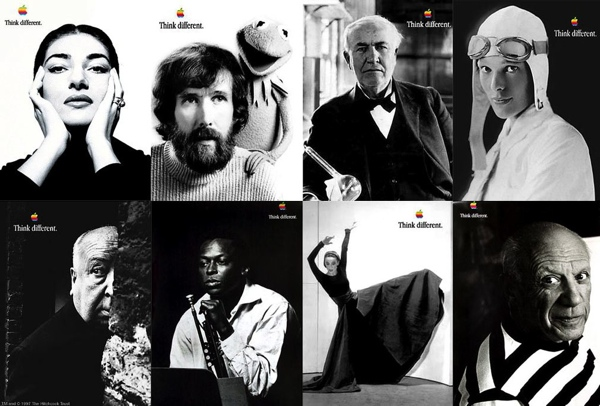Steve Jobs was renowned not only for his visionary contributions to the tech industry but also for his enigmatic ability to create what became famously known as the “Reality Distortion Field”.
(His ability to convince himself and others to believe in almost anything).
This psychological phenomenon enabled Jobs to:
- Motivate teams
- Bend perceptions
- And convince the world of the seemingly impossible.
As we delve into the mysterious realm of Steve Jobs’ RDF, we’ll explore five key themes that underpin this extraordinary power:
- Exaggerated / Minimized Proportion
- Charismatic Authority
- Repetition
- Bravado (Statement Making Moves)
- Appeasement
All these things alter perception, and instill BELIEF that a new outcome / world is possible.
Let’s break it down further.
1. Exaggerated / Minimized Proportion
Jobs had an unparalleled talent for distorting reality by exaggerating or minimizing the importance of various elements. He could make a small task/improvement sound revolutionary, while downplaying significant challenges as mere bumps in the road.
Steve knew how to emphasize and/or de-emphasize proportion to change the perception of a task. (And make it more digestible).
During the development of the Macintosh computer in 1984, Jobs asked an engineer to reduce the boot time by 10 seconds.
When the engineer said it wasn’t possible, Jobs replied:
“If it would save a person’s life, could you find a way to shave 10 seconds off the boot time?”
The engineer said that he could.
Jobs went to a white board and pointed out that if 5 million people wasted an additional 10 seconds booting the computer, the sum time of all users would be equivalent to 100 human lifetimes every year.
A few weeks later the engineer returned with rewritten code that booted 28 seconds faster than before.
Another example of his manipulation of proportion was evident in his product launches, where every detail was meticulously presented to create an awe-inspiring narrative.
During the launch of the iPhone in 2007, Jobs presented the device as three groundbreaking products in one:
- A widescreen iPod with touch controls
- A revolutionary mobile phone
- And a breakthrough internet communications device.
By blending these elements seamlessly into a larger whole, Jobs masterfully emphasized the transformative nature of the iPhone, forever changing the smartphone landscape.
Simultaneously, he downplayed potential issues such as battery life or the lack of a physical keyboard, steering the narrative away from potential criticisms. This skill to manipulate proportion within the RDF allowed Jobs to create an aura of invincibility around Apple’s products.
2. Charismatic Authority
At the core of Jobs’ Reality Distortion Field was his charismatic authority. Jobs possessed an innate ability to captivate and inspire his audience.
His charismatic demeanor, coupled with an unwavering self-confidence, made people believe in his vision and follow him with unquestionable loyalty.
When people have authority, their words hold more weight. We pay attention on a deeper level when they’re communicating with us.
Steve’s personal charisma also contributed to a cognitive bias known as the “halo effect”. This diffused a positive energy and a sense of greatness.
Jobs’ charismatic authority was particularly evident in his famous keynote presentations.
With a charismatic swagger, he would declare:
“One more thing,”
before revealing a groundbreaking product or feature.
This phrase became a symbol of Jobs’ unpredictable and compelling nature, enhancing the mystique of his RDF.
The charismatic authority within the RDF not only influenced Apple employees but also extended to consumers and competitors. Jobs’ ability to convey passion and conviction in his ideas was a driving force behind the cult-like following that Apple still enjoys to this day.
3. Repetition

Repetition played a crucial role in reinforcing Jobs’ Reality Distortion Field.
Jobs had a knack for emphasizing key messages through consistent repetition, embedding them in the minds of his audience.
This repetition created a sense of familiarity and conviction, making it difficult for skeptics to resist the allure of his vision.
The “Think Different” campaign is a prime example of Jobs’ effective use of repetition.
Through a series of iconic advertisements, Apple celebrated the rebels, the misfits, and the troublemakers who dared to think differently. Jobs reiterated this theme in various presentations, making it a central tenet of Apple’s brand identity.
By repeating key messages, Jobs not only instilled confidence in his team but also established a brand narrative that resonated with consumers. The RDF thrived on these repeated messages, shaping perceptions and solidifying Apple’s position as an innovator.
4. Bravado (Statement Making Moves)
Jobs’ Reality Distortion Field was also characterized by a sense of bravado.
He was known for making bold claims and setting audacious goals that seemed unattainable at first glance. This bravado served to inspire and push Apple’s teams to achieve greatness, driving innovation and overcoming seemingly impossible challenges.
When introducing the MacBook Air in 2008, Jobs pulled the incredibly thin laptop out of a standard interoffice envelope to emphasize its groundbreaking design. This statement-making theatrical gesture was a manifestation of his bravado, presenting the MacBook Air not just as a tech marvel but as a symbol of Apple’s ability to redefine industry standards.
The RDF’s bravado was not without risks, as the gap between bold promises and actual delivery could be wide. However, Jobs’ charisma and ability to deliver on some of the most audacious claims reinforced the perception that Apple was capable of achieving the impossible.
5. Appeasement
Jobs’ Reality Distortion Field was not solely about grandiose visions and charismatic displays.
It also involved a subtle element of appeasement, strategically addressing concerns or criticisms to maintain the illusion of perfection. Jobs had a knack for acknowledging flaws while swiftly redirecting focus toward the positive aspects of a product or strategy.
During the Antennagate controversy surrounding the iPhone 4’s reception issues, Jobs held a press conference to address the concerns. While acknowledging the problem, he emphasized that it was not unique to Apple and showcased videos of similar issues with competitors’ phones. This act of appeasement helped mitigate the negative impact on Apple’s reputation and maintained confidence in the RDF.
Conclusion
Steve Jobs’ Reality Distortion Field remains a fascinating phenomenon that continues to be studied and discussed in the realms of business and psychology.
The main engine behind the RDF was Steve’s ability to shift attention onto key leverage points.
(Thus winning the mental game).
By exploring the themes of:
- Exaggerated / Minimized Proportion
- Charismatic authority
- Repetition
- Bravado (Statement Making Moves)
- And appeasement
we gain insights into the nuanced tactics Jobs employed to shape perceptions, rally teams, and captivate the world.
While the reality distortion field was undoubtedly a double-edged sword, its impact on Apple’s success and Jobs’ legacy is undeniable.
Want to learn more about applying this to create the life of your dreams?
You May Also Like:
Robert DeNiro: Profitable and Timeless Communication Principles
11 Playboy Traits All Legendary Bon Vivants Share
"The Hero With A Thousand Faces" - Book Review
Trying Too Hard? The Truth About Social Status No One Talks About
How To Master Self Confidence The Simple Way
The Hidden Energy Shift That Gets You Everything (While Others Keep Failing)
So You Want The Keys To A Good Friendship
How To Overcome Toxic Shame - Get Rid Of Your Negative Self-Image Once And For All
My name is Mister Infinite. I've written 600+ articles for people who want more out of life. Within this website you will find the motivation and action steps to live a better lifestyle.


